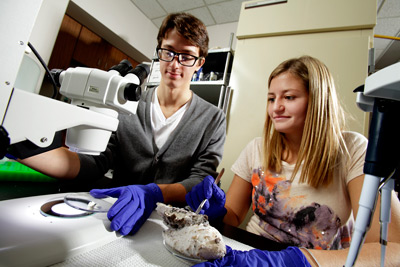
Misericordia faculty, student researchers developing high throughput assay to test large numbers of samples
Dallas, PA — No one knows where the next miracle drug will be found. It may be discovered in the tissues of plants and animals living in the murky swamps of Florida, the dense tropical rainforests of Brazil or the muddy ponds of Northeastern Pennsylvania.
Due to the rise of drug-resistant microbes and new and emerging infectious diseases, the search is on to find a new generation of drugs that will combat infection and treat patients with infectious diseases. Antimicrobial agents — including antibiotics — have been used for decades to cure and treat everything from strep throat to post-operative infections. However, their overuse and misuse have allowed rare bacteria that are resistant to drugs to proliferate.
These new strains of bacteria often result in infections that cannot be controlled by common antibiotics. In some cases, resistant forms of bacteria evolve and spread rapidly through the body and cause life threatening complications or even death. “We are facing new challenges from new strains of common bacteria that are resistant to standard control measures,’’ explains Frank DiPino, Ph.D., professor of biology at Misericordia University. “They are creating new challenges because they are not responding to our current battery of antibiotics.’’
The process is analogous to an arms race in that microbes become virulent by evolving new ways to invade the normally sterile tissues of the human body and to evade human immune and drug defenses. Through evolution, these microbes are designed and fine tuned to be more successful at reproducing — oftentimes in a human host.
So around the globe, research scientists are working on ways to catch up to these microbes. In a Misericordia University laboratory, Dr. DiPino and his student researchers are developing and testing a high throughput process that enables them to test up to 96 samples within minutes for the presence of antimicrobial agents.
“If we are having a hard time finding antimicrobials, maybe its’ because we are looking in the wrong places,’’ Dr. DiPino says. “Antimicrobials can be produced by almost any organism and it is difficult to predict where the next powerful antimicrobial will be found. That’s where I think the high throughput assay comes in because we might find them in places that we did not expect. The technique is similar to panning for gold or ‘bioprospecting’ since we are looking for a relatively rare and desired substance in a vast amount of common, useless material.’’
The search for a new generation of antimicrobials began shortly after research scientists discovered them in alligator blood a few years ago. Despite their aggressive nature, the reptiles rarely develop serious infections from their wounds and now researchers know why. Alligators appear to have serum that contains potent antibacterial proteins. The discovery has teams of investigators looking for other sources in amphibians, aquatic vertebrates and plants so they can discover new antibacterial agents that can be used to combat new strains of human pathogens.
“It’s really important as an undergraduate to gain this type of experience. I visited a lot of (graduate) schools this summer and I met with different professors who asked me if I am working on any research,’’ says Kassie Lutchko ‘11, a biology major who wants to attend graduate school for microbiology and immunology. “We apply a lot of techniques we learn in class, but I feel it is more important to learn them while doing research because we are going to use them for our post-grad work and in our professions.’’
In their search for antimicrobials, Misericordia undergraduate student researchers have already examined fish blood and heart tissue, frog skin and frog eggs, as well as plants and animals. Student researchers Samantha Dunleavy ’13 of Dunmore, Pa.; Katie Kilmer ’13 of Nicholson, Pa.; Neil Dorman ’13 of Larksville, Pa., and Lutchko of Wilkes-Barre, Pa., began working with Dr. DiPino in the spring 2010 semester to develop a method of protocol for detecting antimicrobials by using a high throughput approach so scientists can expand the search and scope of their investigations.
“We’re excited about the opportunity to perform this research on a topic that is brand new,’’ Dorman, a doctoral candidate in physical therapy, expresses after a recent experiment. “It’s exciting to try and find out what might have these properties. It’s like connecting the dots.’’
“Our research is a new topic that current scientists are exploring,’’ adds Dunleavy, who is seeking her doctorate in physical therapy. “It’s really fascinating how we are exploring how common, simple bacteria may possess antimicrobial agents and other organisms. New things are being explored and we are finding out about them.’’
Misericordia researchers have tested about 30 assays using the high throughput methodology with varying degrees of success. In the world of research and discovery, Dr. DiPino says investigators need consistent results with many different variables to prove their system works or their hypothesis is correct.
“It’s a great opportunity because it allows us to apply what we’ve learned,’’ adds Kilmer, who is working towards her doctorate in physical therapy. “It’s great that our institution allows us to work one-on-one with our professors to do a research project like this.’’
Today, Misericordia researchers are focusing their efforts on determining if their assay works and then retesting the extracts they’ve prepared. Tomorrow, the high throughput process designed at MU may enable a scientist to develop the next miracle drug. “I’m excited about having the opportunity to test a lot of samples,’’ Dr. DiPino acknowledges. “Do I think we will find a new cure-all tomorrow? No. But our undergrads are exploring the possibilities and learning research processes. And who knows? There’s no reason we couldn’t come across a sample that’s a very powerful antimicrobial once this method is developed.’’
“A lot of undergraduate students don’t get to do substantial research like this, especially something that may make a real difference,’’ adds Dorman. “But because we’re a smaller school, we really get the help of our faculty to do the research.’’
For more information about Misericordia University, please log on to www.misericordia.edu or call (570) 674-6400. Founded and Sponsored by the Sisters of Mercy in 1924, Misericordia University is Luzerne County’s first four-year college and offers 32 bachelor’s, master’s and doctoral degree programs in three colleges in full- and part-time formats.
Quick Info: Antimicrobials are agents that destroy or inhibit the growth of microorganisms, such as bacteria or fungi. Antimicrobial drugs either kill germs or prevent the growth of germs.
PhotoCaptions:
Misericordia antimicrobial research 1: Frank DiPino, Ph.D., professor of biology at Misericordia University, is working with student researchers, from left, Kassie Lutchko of Wilkes-Barre, Pa.; Katie Kilmer of Nicholson, Pa.; Samantha Dunleavy of Dunmore, Pa., and Neil Dorman of Larksville, Pa., have been working to develop a method of protocol for detecting antimicrobials by using a high throughput approach so scientists can expand the search and scope of their investigations.
(TOP) Misericordia antimicrobial research 2: Misericordia University student Kassie Lutchko of Wilkes-Barre, Pa., is working with Frank DiPino, Ph.D., professor of biology, to develop a high throughput assay to discover new antimicrobial agents.
Misericordia antimicrobial research 3: Misericordia University student researchers Neil Dorman of Larksville, Pa., left, and Katie Kilmer of Nicholson, Pa., are examining samples in search of antimicrobials.
Student researchers Samantha Dunleavy ’13 of Dunmore, Pa.; Katie Kilmer ’13 of Nicholson, Pa.; Neil Dorman ’13 of Larksville, Pa., and Lutchko of Wilkes-Barre, Pa.,
Kassie Lutchko ‘11, a biology major who wants to attend graduate school for microbiology and immunology






















